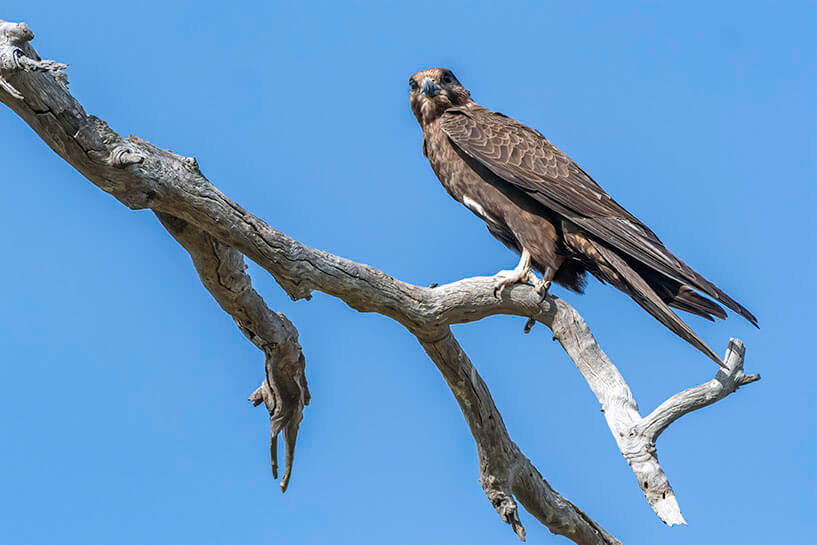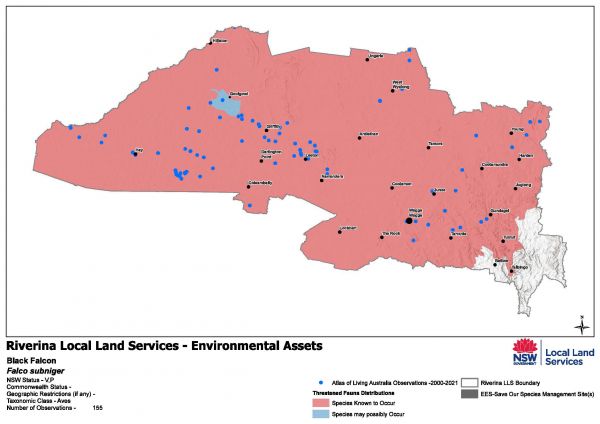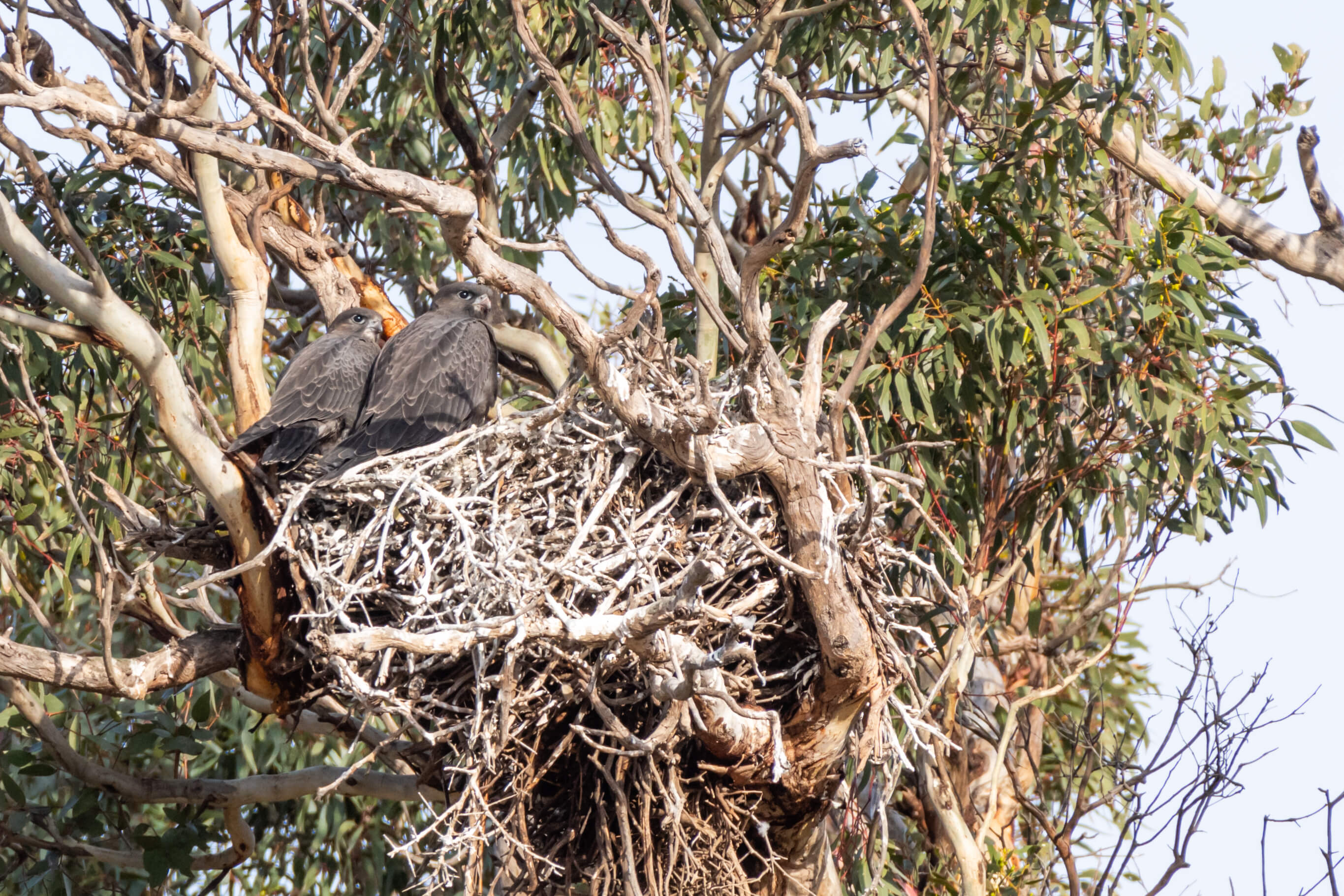Black Falcon
The Black Falcon is a unique, endemic Australian falcon found nowhere else in the world. It is a large, dark and sleek falcon with very pointed wings, and is a fast and agile hunter of flying prey, or ground prey that it can snatch in flight without landing. In farmland, much of its prey consists of agricultural pests such as galahs, corellas, Indian mynas, young rabbits, rats, mice and locusts, so it is a useful bird to have around. It may be noticed when it follows or attends farm machinery, vehicles, mobs of livestock, shooters, fires, or flooding of irrigation paddocks, to catch prey flushed out or injured by human activity. Black Falcons also eat some carrion such as road-killed animals.
About Black Falcons
The Black Falcon is considered threatened, being listed as vulnerable fauna in NSW.
What do Black Falcons look like?
Black Falcons are uniformly dark, ranging from chocolate brown to dark sooty brown. At close range, the white chin and some fine pale barring under the wings and tail may be visible. The short legs are hidden by long thigh feathers.
In the air, Black Falcons have a light, quick and easy style of flapping, though they can fly rapidly when chasing prey. They soar and glide on flat, level or slightly lowered wings, and can soar high on thermals with little flapping. They do not hover, or perch on powerlines.
Black Falcons are often confused with the more common Brown Falcon. The Black Falcon flies with swift, powerful beats, whereas Brown Falcons fly more slowly and heavily, soar and glide on raised wings, hover heavily, and often perch on powerlines.
Brown Falcons vary in colour, from almost as pale as a Nankeen Kestrel to as dark as a Black Falcon. The darkest Brown Falcons always show prominent, broad pale barring in the wings and tail in flight. Brown Falcons have long grey legs exposed by short thigh feathers. Brown Falcons are also very vocal, commonly cackling and screeching.
Where are black Falcons found?
Black Falcons are most likely to be seen on the western slopes and plains, although they visit the tablelands and occur in the drier and more open coastal valleys and floodplains. Black Falcons live in woodland, grassland and tree-dotted agricultural land in flat to undulating terrain, and will hunt over pasture and crops. They nest in the tallest living trees in mature woodland patches or in paddock trees, often on or near creek gullies and other watercourses or wetlands. They use the vacant stick nest of a crow or raven, or sometimes of another bird of prey larger than themselves, including the Wedge-tailed Eagle. They occasionally use stick nests on artificial structures such as power pylons or rural windmill platforms. They like to perch on standing dead or dead-topped trees near their nest sites.
Local Land Services staff have been working on a project StoryMap, featuring interesting details of the Black falcon, and what steps are being taken to save this endangered species in the Riverina. View the storymap here.
Why are Black Falcons a threatened species?
The Black Falcon is considered threatened, being listed as vulnerable fauna in NSW. There are thought to be at least 10,000 Black Falcons in Australia, or perhaps between 3,000 and 5,000 individuals in NSW. Black Falcons face several threats arising from human activities, including:
- clearing of tall creekline or floodplain eucalypts
- loss of nests and nest trees to storms (through exposure of isolated trees in cleared landscapes), competition for and interference at nests by crows or ravens and Sulphur-crested Cockatoos
- and collisions with wires, fences, vehicles and wind turbines
- they may also be affected by locust sprays, by eating rabbits poisoned by pindone or rodents poisoned by second-generation anti-coagulant rodenticides, or by lead poisoning from eating carrion shot with lead ammunition.

Figure 1. Black Falcon at Ripleys Road.
Securing the Black Falcon in the Riverina
The Securing the Black Falcon in the Riverina project aims to protect and enhance native active nest sites, as well as establish new artificial nesting sites.
This level of protection of the nesting resource will encourage breeding and expand the Black Falcon population in the Riverina priority area. Funding is now available through the Environmental Trusts Restoration and Rehabilitation Program for protection of the Black Falcon.
The project will run for three years, with initial expressions of interest to gather baseline data beginning late 2022.
We are keen to hear from landholders who:
- have seen Black Falcons in the local area
- believe that they have active or inactive Black Falcon nests on their property
- have areas of potential habitat for nesting
- are interested in undertaking activities to improve nesting areas for the Black Falcon
- are willing to allow construction of artificial nesting sites on their property.

Figure 2. Black Falcon project area.
Located in central southern NSW, the Riverina priority area extends from Narrandera in the east to west of Hay in the west.
The Riverina Local Land Services boundary forms the southern border, with the priority area extending northward past Goolgowi.
The region contains a diversity of habitats, many of which provide habitat for Black Falcons. Grasslands, chenopod shrublands and waterbodies are important remnant foraging habitat, while woodlands and riparian forests are important for nesting.
Project eligibility
To be eligible to apply the following criteria must be met:
- your property must reside with the Riverina local Land Services region and within the project area (see map)
- all previous works funded by Riverina Local Land Services must be completed and maintained
- you must be wiling to enter into a contractual agreement with Riverina Local Land Services for 10 years
- you must have no outstanding debts to local Land Services
- works will need to be completed within the 12 months from the date of signing the agreement.
How you can help the Black Falcon
Most of the Black Falcon’s problems arise from human impacts on the rural landscape. Landholders can encourage Black Falcons to remain in or return to the area by the following:
- retain mature woodland or paddock trees on farms, especially on watercourses or near wetlands
- regenerate or replant areas of native woodland in treeless areas
- avoid using barbed wire on fences, or make the top strand plain wire and the next strand barbed, or flag collision black spots to make them more visible
- practise regenerative agriculture, to avoid overgrazing
- deny food to crows/ravens and cockatoos by managing livestock carrion and grain spillage to reduce their availability
- be wildlife aware when driving
- use 1080 (“ten-eighty”) baits for rabbits in preference to pindone, were possible
- use first-generation rodenticides based on warfarin or coumatetralyl, rather than second-generation types based on brodifacoum, bromadiolone or difenacoum (read product labels carefully), or consider alternatives to anticoagulants, for example, cholecalciferol (vitamin D3)
- consider alternatives to lead ammunition. For example copper bullets, stainless steel shot
- trial artificial stick nests for the Black Falcon in suitable sites.

Figure 3. Family of Black Falcons at Greystones.
For more information
Contact Kate Jenkins – Project Officer in the Riverina via kate.jenkins@lls.nsw.gov.au
Photos supplied by David Whelan.
This project is a partnership between the NSW Environmental Trust and Riverina Local Land Services.